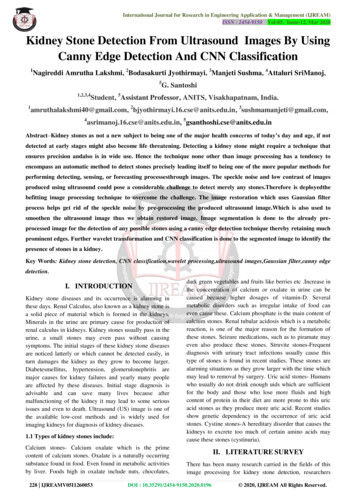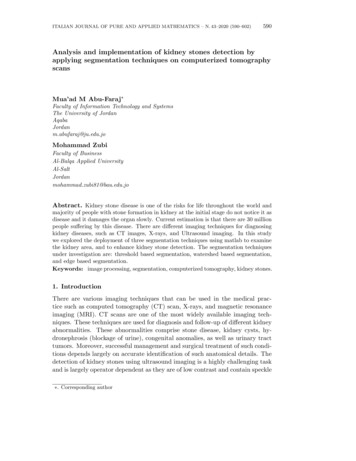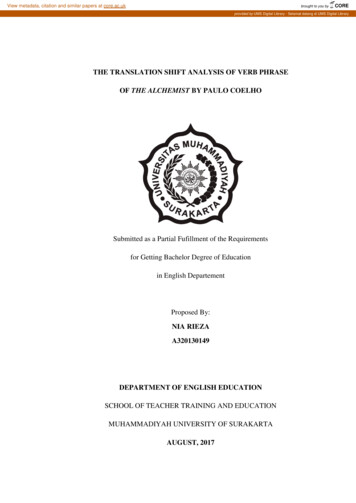
Transcription
International Journal for Research in Engineering Application & Management (IJREAM)ISSN : 2454-9150 Vol-05, Issue-12, Mar 2020Kidney Stone Detection From Ultrasound Images By UsingCanny Edge Detection And CNN Classification1Nagireddi Amrutha Lakshmi, 2Bodasakurti Jyothirmayi, 3Manjeti Sushma, 4Attaluri SriManoj,51,2,3,41G. SantoshiStudent, 5Assistant Professor, ANITS, Visakhapatnam, India.amruthalakshmi40@gmail.com, 2bjyothirmayi.16.cse@anits.edu.in, du.in, 5gsanthoshi.cse@anits.edu.inAbstract–Kidney stones as not a new subject to being one of the major health concerns of today’s day and age, if notdetected at early stages might also become life threatening. Detecting a kidney stone might require a technique thatensures precision andalso is in wide use. Hence the technique none other than image processing has a tendency toencompass an automatic method to detect stones precisely leading itself to being one of the more popular methods forperforming detecting, sensing, or forecasting processesthrough images. The speckle noise and low contrast of imagesproduced using ultrasound could pose a considerable challenge to detect merely any stones.Therefore is deployedthebefitting image processing technique to overcome the challenge. The image restoration which uses Gaussian filterprocess helps get rid of the speckle noise by pre-processing the produced ultrasound image.Which is also used tosmoothen the ultrasound image thus we obtain restored image. Image segmentation is done to the already preprocessed image for the detection of any possible stones using a canny edge detection technique thereby retaining muchprominent edges. Further wavelet transformation and CNN classification is done to the segmented image to identify thepresence of stones in a kidney.Key Words: Kidney stone detection, CNN classification,wavelet processing,ultrasound images,Gaussian filter,canny edgedetection.I. INTRODUCTIONKidney stone diseases and its occurrence is alarming inthese days. Renal Calculus, also known as a kidney stone isa solid piece of material which is formed in the kidneys.Minerals in the urine are primary cause for production ofrenal calculus in kidneys. Kidney stones usually pass in theurine, a small stones may even pass without causingsymptoms. The initial stages of these kidney stone diseasesare noticed latterly or which cannot be detected easily, inturn damages the kidney as they grow to become larger.Diabetesmellitus, hypertension, glomerulonephritis aremajor causes for kidney failures and yearly many peopleare affected by these diseases. Initial stage diagnosis isadvisable and can save many lives because aftermalfunctioning of the kidney it may lead to some seriousissues and even to death. Ultrasound (US) image is one ofthe available low-cost methods and is widely used forimaging kidneys for diagnosis of kidney diseases.1.1 Types of kidney stones include:Calcium stones- Calcium oxalate which is the primecontent of calcium stones. Oxalate is a naturally occurringsubstance found in food. Even found in metabolic activitiesby liver. Foods high in oxalate include nuts, chocolates,228 IJREAMV05I1260053dark green vegetables and fruits like berries etc .Increase inthe concentration of calcium or oxalate in urine can becaused because higher dosages of vitamin-D. Severalmetabolic disorders such as irregular intake of food caneven cause these. Calcium phosphate is the main content ofcalcium stones. Renal tubular acidosis which is a metabolicreaction, is one of the major reason for the formation ofthese stones. Seizure medications, such as to piramate mayeven also produce these stones. Struvite stones-Frequentdiagnosis with urinary tract infections usually cause thistype of stones is found in recent studies. These stones arealarming situations as they grow larger with the time whichmay lead to removal by surgery. Uric acid stones- Humanswho usually do not drink enough uids which are sufficientfor the body and those who lose more fluids and highcontent of protein in their diet are more prone to this uricacid stones as they produce more uric acid. Recent studiesshow genetic dependency in the occurrence of uric acidstones. Cystine stones-A hereditary disorder that causes thekidneys to excrete too much of certain amino acids maycause these stones (cystinuria).II. LITERATURE SURVEYThere has been many research carried in the fields of thisimage processing for kidney stone detection, researchersDOI : 10.35291/2454-9150.2020.0196 2020, IJREAM All Rights Reserved.
International Journal for Research in Engineering Application & Management (IJREAM)ISSN : 2454-9150 Vol-05, Issue-12, Mar 2020used many kinds of algorithms for finding the stone in akidney.[2] In this paper they studied about the early stagedetection of kidney stones by using improved seeded regiongrowing based segmentation and classified kidney imagesaccording to the stone size, intensity threshold change wasextracted from the segmented parts of image and size ofstone was compared with normal standard stone size. (lessthan 2 mm absence of stone, 2-4 mm early occurrence stage, 5mm and above presence of kidney stones) Ultrasoundkidney image samples taken from the clinical laboratorytheir results included diagnosing the kidney stones byvarying the intensity threshold presence and absence alongwith the early stages of stone formation. [3] In this systemkidney stone disease is diagnosed using two different neuralarchitectures, those are Learning Vector quantization (LVQ)and Radial basis function(RBF) these are compared amongthem to get the best result. They used Waikato Environmentfor Knowledge analysis (WEKA) version 3.7.5 as simulator.They took real world dataset with 1000 instances and 8attributes.[4] In this paper, we first proceed for theenhancement of the image with the help of median filter,Gaussian filter and un-sharp masking.some operations likeerosion,dilation and entropy based segmentation employ todiscover the region of interest. At last KNN and SVMclassification methods are used for the survey of kidneystones. [5]CAD algorithm based on FGPA was used fordetection of abnormality in kidneys. Noise present in ultrasound image is removed first and then segmented .Featureslike intensive histogram and haralick were obtained from thesegmented image. Later classification was performedfollowing two process one is differentiating between healthykidney and unhealthy kidney by using lookup table approach,if the abnormality in the kidney is confirmed further theimage is processed with the help of support vectormachine(SVM) and MLP trained with specific features toidentify the presence of cyst or stone. [6]Developed a methodof automated feature description of renal size. Analysis onkidney size compared within a normal and abnormal areperformed. The accuracy between manual method andautomated method varied a lot i.e a difference of 10% manualgave an accuracy of 81% and automated with 91%.III. PROPOSED ALGORITHMThe project is divided into 4 modules3.1. Image pre-processing.3.2. Image segmentation.3.3. Wavelet processing.3.4. CNN classification.3.1 Image Pre-ProcessingUltrasound images are prone to have some noise in theirinitial stage because of its low contrast. Pre-processingconsists of Image restoration, Smoothing, sharpening,Contrast enhancement. Pre-processing is a operation withimages at the lowest level of abstraction both input andoutput images. The image which is usually represented by a229 IJREAMV05I1260053matrix of brightness function has to made as the originalimages which are captured by some sensor may have lowintensity. The prime aim of image pre-processing is anenhancement of the image data those image featuresimportant for further processing. Geometric transformationsof images such as rotation, scaling, translation are doneamong pre-processing methods which are quite similarmethods.Fig 1: Architecture3.2 Image SegmentmaationSegmentation is an important and major aspect of medicalimaging and digital image processing. It helps invisualizing the data available by providing diagnostics forvarious diseases depending on the given dataset. Cannyedge detection, identifying and sharpening the edge of thekidney and the stone in the kidney are two majorfunctionalities of it. It is one of the level set segmentationtechnique. The process of dividing a digital image intomultiple segments is termed as segmentation of the image.The image is divided into various sets of pixels which arecalled as image objects. Segmentation prime aim is tosimplifyand to represent given image into particular patternwhich even can be used to analyze. The lines, curves,boundaries are located in the process of imagesegmentation and even image objects. Assigning labels toevery pixel of the image and segregating labels havingsame labels which have common characteristics and thisprocess is termed as image segmentation. The resultproduced isimage segmentation, a set of segments whichcover the entire image or a set of contours of the image.The characteristic or property such as colour, intensity andtexture of each of the pixels in a region is similar.3.3 Wavelet ProcessingWavelet transforms are a mathematical procedure ofperforming signal analysis when signal frequency variesover time. Wavelet Transform is particularly selected forthis project as for certain classes and signals this providesDOI : 10.35291/2454-9150.2020.0196 2020, IJREAM All Rights Reserved.
International Journal for Research in Engineering Application & Management (IJREAM)ISSN : 2454-9150 Vol-05, Issue-12, Mar 2020better precise results. Wavelets are commonly used inimage processing to detect and filter white Gaussian noisebecause of their high contrast of intensity values oftheneighbouring pixel. The two-dimensional image in the formof the matrix is feed into wavelet transform. The segmentedimage from the input opted to perform wavelet transform toget a compressed image. The image processed in this waycan be cleaned without destroying the image quality such asblurring and muddling.3.4 CNN ClassificationThe convolutional neural network (CNN) is a sub-part ofdeep learning neural networks. CNN is abundantly used inimage recognition and digital imageprocessing. Analysis ofvisual imagery and image classification are majorfunctionalities of CNN and are quite often used in thesefields. Applications of CNN are be seen from social mediato scientific research. Healthcare and security arefieldswhere we can find CNN used majorly because of itsfunctionalities. Image classification is the process of takingan input and passing it through a black box and outputting aclass or to which probability that the input is a particularclass. CNN can be introspected as automatic featureextraction from the image and using it further in patternrecognition. The adjacent pixel information is usedproductively down-sample the image. CNN has one ormore layers of convolution units. A convolution unit id feedwith input from multiple units from the previous layerwhich together creates proximity. Therefore, the inputunitsshare their weights. The input is in the form of wavelettransform by takinga series of input images. Each image isgiven as input in the form of a matrixto neurons in the inputlayer of the CNN. A smaller matrix termed as filter isselected for the filtering process. The filter multiplies itsvalues by original pixel values and produces another imagematrix. These values are summed up. The convolutioncontinues. Finally, a smaller matrix than the input matrix isobtained. The output matrix of CNN classification iscompared with another ground truth image matrix andclassification is performed.IV. EXPERIMENT AND RESULTSThe first phase involves the dataset preparation. In our case,we have collected some sample ultrasound kidney imageswith and without stones and converted them into a csv filewhich can be used as a dataset in our projectduring theimplementation of CNN classification module. Initially, asthe ultrasound kidney image containsthe speckle noise andis of low contrast, one of the image pre-processingtechnique is being applied to remove the speckle noise. Inthis project, Gaussian filtertechnique is used to blur theimage by using gaussian function to remove the noise. Thispre-processing involves Image restoration, smoothing andsharpening.In the implementation of image segmentationmodule, canny edge detection technique is used toextractthe useful information from the image by reducing oreliminating the information which is not requiredthereby230 IJREAMV05I1260053reducing the amount of data to be processed. This techniqueis used to detect the edgeswhich involves various steps. Thefirst stepis noise reduction using gaussian blur in which a5x5 gaussian filter is used to remove the noise from theobtained pre-processed image. The second step is Gradientcalculation in which the edge intensity and direction aredetected by calculating the gradient using edge detectionoperation. The output of this step involves image containingthick edges. The third step is Non-maximum Suppression.As the output of the algorithm should contain thin edges,thealgorithm finds the pixels with maximum value in the edgedirections by going through the points on the gradientintensity. The fourth step is Double threshold.In this stepwe aim at identifying 3 kinds of pixels: strong, weak, andnon-relevant. Pixels that contribute to the final edge areclassified as strong edges. Pixels with intensity values thatare not sufficient to be classified as strong edges, but notsmall enough to be considered as non-relevant are classifiedas weak pixels. The remaining pixels are considered as nonrelevant pixels. Double threshold is used for categorizingpixels based on the intensity.High threshold identifiesstrong pixels, Low threshold identifies non-relevant pixels,and the other pixels are marked as weak. The result of thisstep includes an image consisting only strong and weakpixels. The fifth step is Edge Tracking, here transformationof weak pixels into strong pixels take place if and only ifthe pixels around the one being processed is a strongone.The output of the Image segmentation module is sent tothe Wavelet Processing module.A wavelet decays swiftlyjust like an oscillation which has zero mean. Unlikesinusoids which extend to infinity, a wavelet exists for afinite duration.The image processed in this way can be“cleaned up” without blurring the details. The output of thismodule is in matrix form containing pixel values of theimage.The fourth module is CNN Classification. The output fromwavelet processing module is a greyscale matrix of size128*128*1. CNN Classification involves 4 steps namelyConvolution layer, Activation function, max Pooling, Fullyconnected network. In Convolution layer a 3*3 kernel isapplied on the input matrix with stride 1, so that the size ofthe image is reduced. The obtained matrix is sent to theactivation function layer, here ReLU(Rectified LinearUnit)activation function is used to eliminate negativevalues. The next step is max pooling, here the rectified mapgoes through a pooling layer, pooling is down samplingoperation that reduces the dimensionality of featuremap.The output of this layer is a matrix with reduced sizecontaining all the features. These 3 steps are repeated fortwo times, in which 32 filters are used each time. The nextstep is Flattering in which we convert the 2D array frompooling into a long continuous linear vector to which afilter of size 64 is applied followed by activation function.Later a Drop Out of size 0.5 is applied to prevent overfitting. In the next step ANN model is applied, in whichDOI : 10.35291/2454-9150.2020.0196 2020, IJREAM All Rights Reserved.
International Journal for Research in Engineering Application & Management (IJREAM)ISSN : 2454-9150 Vol-05, Issue-12, Mar 2020sigmoid activation is used function to detect the presence ofstone.AlgorithmCNNANN’s LVQMedian filter noisereduction ROISourceUltrasound imagesBlood samplesUltraSound imagesAccuracy83%80%70%Table: accuracy measuresFig: Converting matrix into linear array formFig: convolution methodologyfig: output with label yes (presence of stone)V. CONCLUSION AND FUTURE SCOPEIn this project, the survey of different algorithms andclassifications are analyzed followed by the detection ofstone present in the kidney. From this implementation, theexisting system limitations are inferred and a new design isproposed to address the limitations such as level settechniques require considerable thought in order toconstruct velocities to get a perfect advanced level setfunction. This means there should be a huge data availableto get the accuracy rate which is sometimes may not bepossible. We planned to rectify these issues using CNNclassification. The energy levels extracted from the waveletsubbands i.e., Daubechies, Symlets and biorthogonal filtersgives the clear indication of difference in the energy levelscompared to that of normal kidney image if there is stone.The CNN trained with normal kidney image and classifiedinput into normalor abnormal by considering extractedenergy levels from wavelet filters. By using CNNclassification we obtained an accuracy in between 70-85%.Python above 3.6 was used to implement and pycharmsoftware tool was used.REFERENCESFig: output with label No (absence of stone)[1] K.Viswanath,R.Gunasundari, “Design and AnalysisPerformance of Kidney Stone Detection from UltrasoundImage by Level Set Segmentation and ANNClassification.”,2014.[2] Tamilselvi,Thangaraj “Computer Aided Diagnosis Systemfor Stone detection and Early Detection of KidneyStones”,2011.[3] Koushalkumar, Abhishek “Artificial Neural Networks forDiagnosis of Kidney Stones Disease”,2012.[4] ni“Analysis and identification of kidney stone usingKth nearest neighbour (KNN) and support vector machine(SVM) classification techniques”,2017.[5] [5 ] K. Divya Krishna, V. Akkala, R. Bharath, P.Rajalakshmi, A.M. Mohammed, S.N. Merchant,U.B. Desai“Computer Aided Abnormality Detection for Kidney onFPGA Based IoT Enabled Portable Ultrasound ImagingSystem”,2016.[6] Nur Farhana Rosli,Musab Sahrim1,Wan Zakiah alakrishnan,”Automated Feature Description of Renal SizeUsing Image processing”,2018.[7] K.Bommana raja “ Analysis of Ultrasound kidney ImageFig: accuracy of stone detection231 IJREAMV05I1260053using content description multiple features for disorderidentification”,2007.DOI : 10.35291/2454-9150.2020.0196 2020, IJREAM All Rights Reserved.
International Journal for Research in Engineering Application & Management (IJREAM)ISSN : 2454-9150 Vol-05, Issue-12, Mar 2020[8] R.Kimmel, “Fast Edge Detection” in Geometric Level SetMethods in Imaging, Vision and Graphics,Newyork :Springer –Verlag-2003.[9] Thord Anderson, Gunnar Lathen, “Modified Gradient SearchFor Level Set based image Segmentation”,Transactions on image processing ,February 2013.IEEE[10] William G Robertson, “Methods for diagnosing the riskfactors of ] R. Vinoth, K. Bommannaraja “FPGA design of efficientkidney image classification using algebric histogram featuremodel and sparse deep neural network (SDNN)techniques”,2017.[12] Nurul Aimi Shaharuddin, Wan Mahani Hafizah WanMahmud "Feature Analysis of Kidney Ultrasound Image inFour Different Ultrasound using Gray Level Co-occurrenceMatrix (GLCM) and Intensity Histogram (IH)",2018.[13] Akansha Singh, Yun-yun, "Improved Speedup Performancein Automated Segmentation of Kidneys on Abdominal CTImages and Extracting its Abnormalities", Yang2017.[14] Prema T. Akkasaligar, Sunanda Biradar "Diagnosis of renalcalculus disease in medical ultrasound images",IEEE,2016.[15] T. Mangayarkarasi, D. Najumnissa Jamal "Development ofPatient Assistive Tool for Detection of Abnormalities inKidney",2015.[16] M. S. Abirami, T. Sheela "Kidney Segmentation For FindingIts Abnormalities In Abdominal CT Images"2015.[17] Ashraf I. Ahamed, Bassam Mohamed, Faize Basha, M.Mohamed Surputheen "Renal Calculi Detection inUltrasound images and Diagnosis of Images using ImageSegmentation",2014.[18] Rubbal Birdi, Jyoti Gill "3-D Tumor Detection from Kidneysusing UltrasoundImages",2014.[19] M.C.Ranjitha, G.M.Nasira, "Region Descriptors to ExtricateRenal Calculi by Discerning Artifacts from Ultra SoundImages",2015.[20] Samson Isaac,"Ultrasound Image Analysis of Kidney Stoneusing Wavelet Transform",2014.[21] P. Thangaraj, "Segmentation of Calculi from UltrasoundKidney Images by RegionSegmentation Method",2011.232 IJREAMV05I1260053IndicatorwithContourDOI : 10.35291/2454-9150.2020.0196 2020, IJREAM All Rights Reserved.
Key Words: Kidney stone detection, CNN classification,wavelet processing,ultrasound images,Gaussian filter,canny edge detection. I. INTRODUCTION Kidney stone diseases and its occurrence is alarming in these days. Renal Calculus, also known as a kidney stone is a solid piece of material which is formed in the kidneys.










